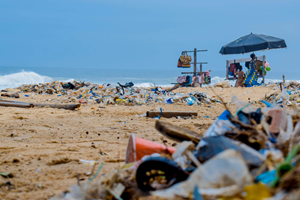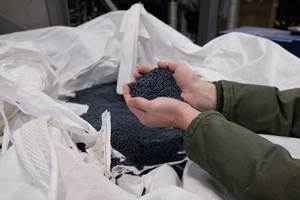PE Market Snapshot: Agricultural Film
Ag film growth over the next five years projected at 6.5%.
We’ve reported on stretch film, t-shirt bags, institutional can liners , consumer can liners, and shrink film, produce film, and pouches in previous installments of this blog series, which provide snap shots of the results of 2017 research conducted by market-research firm Mastio & Co., St. Joseph, Mo. on the PE film industry. Here, we look at its analysis of agricultural film.
As Mastio point outs, agricultural film has numerous purposes. It can increase crop yields and quality, while lowering the need for chemical fertilizers, pesticides, herbicides, and sterilizers. It can also conserve precious natural resources, such as water, nutrients, fossil fuels, and many forms of energy, especially sunlight. In some cases, PE agricultural film can be used to limit sunlight and retain moisture especially in arid regions. It reduces invasive weeds and insects. Additionally, PE agricultural film can make agriculture more productive and efficient by cutting costs and saving time.
Last year, approximately 453.5 million lb of PE resins were consumed in the production of agricultural film, Mastio reports. With an average annual growth rate (AAGR) of 6.5%, Mastio projects the agricultural film market is expected to reach 548 million lb of PE resin consumption by 2020. The anticipated increase can be attributed in part to the development of new technologies, new applications, and greater awareness of the viability of PE film by farmers.
Various types of agricultural film include mulch, greenhouse, pest-control, silage, and water and soil-conservation. According to Mastio’s research, mulch film accounts for more than one-third of the agricultural film produced in North America. PE film competes with many other materials including cloth, paper, straw, burlap, nonwovens, fabric, fiberglass, glass, metal, mulch, and wood chips. However, PE film is a lower cost material, which can result in increased profitability, notes Mastio.
In 2017, the five largest participants in the PE agricultural film market were Poly-America, L.P.; Berry Global Group Inc.; Sigma Plastics Group; Polyethics Industries Inc.; and Next Generation Films Inc., according to Mastio. Collectively, these companies processed approximately 302.5 million lb of PE resin in the production of agricultural film for a combined market share of 66.7%.
MATERIAL TRENDS
During 2017, LLDPE resins—including LLDPE-butene, LLDPE-hexene, LLDPE-octene, LLDPE-super hexene, and LLDPE resin manufactured with the metallocene single-site catalyst process (mLLDPE)—were the primary materials utilized in the production of agricultural films. mLLDPE resin increases film strength and puncture resistance and facilitates even further downgauging. mLLDPE resin is often blended or coextruded with other PE resins in the production of agricultural films.
LDPE—including LDPE-homopolymer, LDPE-ethylene-vinyl acetate copolymer (LDPE-EVA copolymer), LDPE-ethylene-methyl acrylate copolymer (LDPE-EMA copolymer), and LDPE-ethylene-acrylic acid copolymer (LDPE-EAA copolymer)—is typically blended with LLDPE resins in the agricultural film market. Blending LDPE and LLDPE offers improved puncture resistance and stiffness at thinner gauges versus straight LDPE film. Most of the PE resin types used in the agricultural film market yield film with the following characteristics: excellent processability, good impact strength, high puncture resistance, excellent tensile strength, good abrasion resistance, good tear resistance, and stiffness.
FILM EXTRUSION TECHNOLOGY
In 2017, the blown film extrusion process was the most utilized in this market with nearly a 78 percent market share compared to the cast film extrusion process. An industry source stated that cast film clings more tightly to the growing bed, resists elongation, and disperses colors and additives well vs. blown film. Embossed cast film was claimed to improve grip and snap-back of film against growing beds. Additionally, embossed cast film can be produced on one extrusion line, while blown film requires a secondary operation to accomplish embossing.
Coextruded agricultural film structures are typically comprised of two or three layers, and allow producers to further downgauge films while maintaining, or in some cases increasing, film strength. The five- to seven-layer manufacturing process enables the most effective placement of raw materials within the film structure so that they reach those parts of the film where they are most beneficial. This ensures the UV stabilizers are on the outside of the film to face the weather with the inner layers bearing the high strength barrier properties, and puncture resistance elements of exceptionally strong agricultural film mostly used for silage and bale wrap applications. According to Mastio’s research, about 40% of agricultural films produced last year were coextrusions.
Multilayer totally impermeable film (TIF) structures are becoming more popular for fumigation film to assure growers reliable performance. Industry sources indicate that fumigant rates based on gallons per acre may be reduced by as much as 10% to 50% under TIF while still maintaining efficiency and yields. Agricultural films are constantly being downgauged, with mulch film being downgauged from 3 to 1.5 mils. Additionally, mulch films with typical gauges of 1 to 2 mils are now being produced in fractional gauges such as 0.4 and 0.5 mil.
MY TWO CENTS
While larger processors have a sizeable share of this market, it seems as though there is room for smaller players who develop new technologies. Thinner film gauges, higher line speeds, more complex multi-layer structures, TIF structures, and new pigment and additive formulations are
some of the approaches being tested and utilized in persuading farmers to trade up from generic black and white agricultural films to more sophisticated and expensive agricultural film products.
Related Content
Fungi Makes Meal of Polypropylene
University of Sydney researchers identify two strains of fungi that can biodegrade hard to recycle plastics like PP.
Read MorePrices Up for PE, PP, PS, Flat for PVC, PET
Trajectory is generally flat-to-down for all commodity resins.
Read MoreThe Fundamentals of Polyethylene – Part 1: The Basics
You would think we’d know all there is to know about a material that was commercialized 80 years ago. Not so for polyethylene. Let’s start by brushing up on the basics.
Read MoreNew Facility Refreshes Post-Consumer PP by Washing Out Additives, Contaminants
PureCycle prepares to scale up its novel solvent recycling approach as new facility nears completion.
Read MoreRead Next
People 4.0 – How to Get Buy-In from Your Staff for Industry 4.0 Systems
Implementing a production monitoring system as the foundation of a ‘smart factory’ is about integrating people with new technology as much as it is about integrating machines and computers. Here are tips from a company that has gone through the process.
Read MoreMaking the Circular Economy a Reality
Driven by brand owner demands and new worldwide legislation, the entire supply chain is working toward the shift to circularity, with some evidence the circular economy has already begun.
Read MoreFor PLASTICS' CEO Seaholm, NPE to Shine Light on Sustainability Successes
With advocacy, communication and sustainability as three main pillars, Seaholm leads a trade association to NPE that ‘is more active today than we have ever been.’
Read More


























